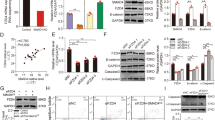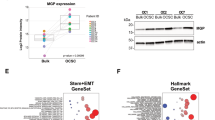Abstract
Platelet-derived growth factor alpha (PDGFA) is frequently upregulated in various cancers and thought to function as a key player in the development and progression of tumor growth by regulating aspects of cell proliferation, angiogenesis and metastasis. However, the mechanism by which it is upregulated is not fully understood. Previously, we demonstrated that conditional deletion of two transcription factors that signal for the bone morphogenetic proteins (Smad1 and Smad5) in ovarian granulosa cells causes metastatic granulosa cell tumors (GCTs) in female mice and phenocopies human juvenile GCTs (JGCTs). Smad1/5 double conditional knockout tumors, as well as human JGCTs, are highly vascularized, hemorrhagic and mitotically active. Expression analysis of these tumors and their metastases revealed a significant upregulation of key proliferation and pro-angiogenic factors such as Pdgfa, Pdgfb and Vegf. We examined whether these genes were direct targets of SMAD1 and SMAD5. Knockdown of SMAD1 and SMAD5 in mouse primary granulosa cells and a human GCT-derived cell line (COV434) resulted in upregulation of PDGFA, but not PDGFB nor VEGF. We identified several putative SMAD1/5-binding sites in the PDGFA promoter, and chromatin immunoprecipitation and reporter assays demonstrated that SMAD1/5 interact with the PDGFA promoter to regulate its activity. Further, SMAD1/5 antagonize the activity of the transcription factor Sp1, a well-known positive regulator of PDGFA, by inhibiting its occupancy at a key regulatory site on the proximal PDGFA promoter. Collectively, our studies establish that loss of SMAD1/5 leads to upregulation of PDGFA in ovarian granulosa cells, and that a novel regulatory interaction exists between the BR-SMADs and Sp1 in controlling PDGFA expression during granulosa cell tumorigenesis.
This is a preview of subscription content, access via your institution
Access options
Subscribe to this journal
Receive 50 print issues and online access
$259.00 per year
only $5.18 per issue
Buy this article
- Purchase on Springer Link
- Instant access to full article PDF
Prices may be subject to local taxes which are calculated during checkout








Similar content being viewed by others
References
Ikushima H, Miyazono K . TGFbeta signalling: a complex web in cancer progression. Nat Rev Cancer 2010; 10: 415–424.
Thawani JP, Wang AC, Than KD, Lin C-Y, La Marca F, Park P . Bone morphogenetic proteins and cancer: review of the literature. Neurosurgery 2010; 66: 233–246.
Howe JR, Bair JL, Sayed MG, Anderson ME, Mitros FA, Petersen GM et al. Germline mutations of the gene encoding bone morphogenetic protein receptor 1A in juvenile polyposis. Nat Genet 2001; 28: 184–187.
Kodach LL, Wiercinska E, de Miranda NFCC, Bleuming SA, Musler AR, Peppelenbosch MP et al. The bone morphogenetic protein pathway is inactivated in the majority of sporadic colorectal cancers. Gastroenterology 2008; 134: 1332–13341.
Edson MA, Nalam RL, Clementi C, Franco HL, DeMayo FJ, Lyons KM et al. Granulosa cell-expressed BMPR1A and BMPR1B have unique functions in regulating fertility but act redundantly to suppress ovarian tumor development. Mol Endocrinol 2010; 24: 1251–1266.
Pangas SA, Li X, Umans L, Zwijsen A, Huylebroeck D, Gutierrez C et al. Conditional deletion of Smad1 and Smad5 in somatic cells of male and female gonads leads to metastatic tumor development in mice. Mol Cell Biol 2008; 28: 248–257.
Middlebrook BS, Eldin K, Li X, Shivasankaran S, Pangas SA . Smad1-Smad5 ovarian conditional knockout mice develop a disease profile similar to the juvenile form of human granulosa cell tumors. Endocrinology 2009; 150: 5208–5217.
Andrae J, Gallini R, Betsholtz C . Role of platelet-derived growth factors in physiology and medicine. Genes Dev 2008; 22: 1276–1312.
Uhrbom L, Hesselager G, Nistér M, Westermark B . Induction of brain tumors in mice using a recombinant platelet-derived growth factor B-chain retrovirus. Cancer Res 1998; 58: 5275–5279.
Bruna A, Darken RS, Rojo F, Ocaña A, Peñuelas S, Arias A et al. High TGFbeta-Smad activity confers poor prognosis in glioma patients and promotes cell proliferation depending on the methylation of the PDGF-B gene. Cancer Cell 2007; 11: 147–160.
Yu PB, Hong CC, Sachidanandan C, Babitt JL, Deng DY, Hoyng SA et al. Dorsomorphin inhibits BMP signals required for embryogenesis and iron metabolism. Nat Chem Biol 2008; 4: 33–41.
Korchynskyi O, Ten DP . Identification and functional characterization of distinct critically important bone morphogenetic protein-specific response elements in the Id1 promoter. J Biol Chem 2002; 277: 4883–4891.
López-Rovira T, Chalaux E, Massagué J, Rosa JL, Ventura F . Direct binding of Smad1 and Smad4 to two distinct motifs mediates bone morphogenetic protein-specific transcriptional activation of Id1 gene. J Biol Chem 2002; 277: 3176–3185.
Pinkas H, Fisch B, Rozansky G, Felz C, Kessler-Icekson G, Krissi H et al. Platelet-derived growth factors (PDGF-A and -B) and their receptors in human fetal and adult ovaries. Mol Hum Reprod 2008; 14: 199–206.
Zhang H, Vollmer M, De Geyter M, Litzistorf Y, Ladewig A, Dürrenberger M et al. Characterization of an immortalized human granulosa cell line (COV434). Mol Hum Reprod 2000; 6: 146–153.
Morikawa M, Koinuma D, Tsutsumi S, Vasilaki E, Kanki Y, Heldin C-H et al. ChIP-seq reveals cell type-specific binding patterns of BMP-specific Smads and a novel binding motif. Nucleic Acids Res 2011; 39: 8712–8727.
Fei T, Xia K, Li Z, Zhou B, Zhu S, Chen H et al. Genome-wide mapping of SMAD target genes reveals the role of BMP signaling in embryonic stem cell fate determination. Genome Res 2010; 20: 36–44.
Kaetzel DM . Transcription of the platelet-derived growth factor A-chain gene. Cytokine. Growth Factor Rev 2003; 14: 427–46.
Fortin J, Bernard DJ . SMAD3 and EGR1 physically and functionally interact in promoter-specific fashion. Cell Signal 2010; 22: 936–43.
Gashler AL, Bonthron DT, Madden SL, Rauscher FJ, Collins T, Sukhatme VP . Human platelet-derived growth factor A chain is transcriptionally repressed by the Wilms tumor suppressor WT1. Proc Natl Acad Sci USA 1992; 89: 10984–10988.
Khachigian LM, Santiago FS, Rafty LA, Chan OL, Delbridge GJ, Bobik A et al. GC factor 2 represses platelet-derived growth factor A-chain gene transcription and is itself induced by arterial injury. Circ Res 1999; 84: 1258–1267.
Rafty LA, Santiago FS, Khachigian LM . NF1/X represses PDGF A-chain transcription by interacting with Sp1 and antagonizing Sp1 occupancy of the promoter. EMBO J 2002; 21: 334–343.
Khachigian LM, Williams AJ, Collins T . Interplay of Sp1 and Egr-1 in the proximal platelet-derived growth factor A-chain promoter in cultured vascular endothelial cells. J Biol Chem 1995; 270: 27679–27686.
Kaetzel DM, Maul RS, Liu B, Bonthron D, Fenstermaker RA, Coyne DW . Platelet-derived growth factor A-chain gene transcription is mediated by positive and negative regulatory regions in the promoter. Biochem J 1994; 301: 321–327.
Hoffmann A-C, Mori R, Vallbohmer D, Brabender J, Klein E, Drebber U et al. High expression of HIF1a is a predictor of clinical outcome in patients with pancreatic ductal adenocarcinomas and correlated to PDGFA, VEGF, and bFGF. Neoplasia 2008; 10: 674–679.
Yamamoto S, Tsuda H, Takano M, Kita T, Kudoh K, Furuya K et al. Expression of platelet-derived growth factors and their receptors in ovarian clear-cell carcinoma and its putative precursors. Mod Pathol 2008; 21: 115–124.
Shih AH, Holland EC . Platelet-derived growth factor (PDGF) and glial tumorigenesis. Cancer Lett 2006; 232: 139–147.
George D . Targeting PDGF receptors in cancer--rationales and proof of concept clinical trials. Adv Exp Med Biol 2003; 532: 141–151.
Schumer ST, Cannistra SA . Granulosa cell tumor of the ovary. J Clin Oncol 2003; 21: 1180–1189.
Rocconi RP, Matthews KS, Kimball KJ, Conner MG, Baker AC, Barnes MN . Expression of c-kit and platelet-derived growth factor receptors in ovarian granulosa cell tumors. Reprod Sci 2008; 15: 673–677.
Chu S, Alexiadis M, Fuller PJ . Expression, mutational analysis and in vitro response of imatinib mesylate and nilotinib target genes in ovarian granulosa cell tumors. Gynecol Oncol 2008; 108: 182–190.
Gonfloni S, Di Tella L, Caldarola S, Cannata SM, Klinger FG, Di Bartolomeo C et al. Inhibition of the c-Abl-TAp63 pathway protects mouse oocytes from chemotherapy-induced death. Nat Med 2009; 15: 1179–1185.
Pangas SA, Jorgez CJ, Matzuk MM . Growth differentiation factor 9 regulates expression of the bone morphogenetic protein antagonist gremlin. J Biol Chem 2004; 279: 32281–32286.
Loots GG, Ovcharenko I, Pachter L, Dubchak I, Rubin EM . rVista for comparative sequence-based discovery of functional transcription factor binding sites. Genome Res 2002; 12: 832–839.
Iwamori T, Iwamori N, Ma L, Edson MA, Greenbaum MP, Matzuk MM . TEX14 interacts with CEP55 to block cell abscission. Mol Cell Biol 2010; 30: 2280–22892.
Acknowledgements
This work was supported by a Burroughs Wellcome Career award in Biomedical Sciences and a NIH CA138628 to SAP. We thank Dr David Kaetzel (University of Kentucky) for the PDGFA luciferase plasmids, Drs An Zwijsen (Leuven University), Elizabeth Robertson (University of Oxford), and Richard R Behringer (MD Anderson Cancer Center) for mouse lines, and Dr Xin-Hua Feng (Baylor College of Medicine) for the flag-tagged SMAD1 and SMAD5 expression plasmids. We thank Rebecca James, Hermann Piard and Yuxuan Lin for technical assistance and Nadera Mansouri-Attia, Krishna Jagarlamudi for critical reading of the manuscript.
Author information
Authors and Affiliations
Corresponding author
Ethics declarations
Competing interests
The authors declare no conflict of interest.
Additional information
Supplementary Information accompanies the paper on the Oncogene website
Supplementary information
Rights and permissions
About this article
Cite this article
Tripurani, S., Cook, R., Eldin, K. et al. BMP-specific SMADs function as novel repressors of PDGFA and modulate its expression in ovarian granulosa cells and tumors. Oncogene 32, 3877–3885 (2013). https://doi.org/10.1038/onc.2012.392
Received:
Revised:
Accepted:
Published:
Issue Date:
DOI: https://doi.org/10.1038/onc.2012.392
Keywords
This article is cited by
-
The role of microenvironment in tumor angiogenesis
Journal of Experimental & Clinical Cancer Research (2020)
-
miR-6086 inhibits ovarian cancer angiogenesis by downregulating the OC2/VEGFA/EGFL6 axis
Cell Death & Disease (2020)
-
Genes responsible for proliferation, differentiation, and junction adhesion are significantly up-regulated in human ovarian granulosa cells during a long-term primary in vitro culture
Histochemistry and Cell Biology (2019)
-
The molecular mechanism of ovarian granulosa cell tumors
Journal of Ovarian Research (2018)
-
Exosomes derived from human adipose mesenchymal stem cells improve ovary function of premature ovarian insufficiency by targeting SMAD
Stem Cell Research & Therapy (2018)



